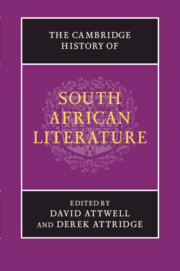Book contents
- Frontmatter
- Introduction
- PART I ORATURES, ORAL HISTORIES, ORIGINS
- PART II EXPLORATION, EARLY MODERNITY AND ENLIGHTENMENT AT THE CAPE, 1488–1820
- 6 Shades of Adamastor: the legacy of The Lusiads
- 7 In the archive: records of the Dutch settlement and the contemporary novel
- 8 Eighteenth-century natural history, travel writing and South African literary historiography
- PART III EMPIRE, RESISTANCE AND NATIONAL BEGINNINGS, 1820–1910
- PART IV MODERNISM AND TRANSNATIONAL CULTURE, 1910–1948
- PART V APARTHEID AND ITS AFTERMATH, 1948 TO THE PRESENT
- PART VI SOUTH AFRICAN LITERATURE: CONTINUITIES AND CONTRASTS
- Index
- References
7 - In the archive: records of the Dutch settlement and the contemporary novel
from PART II - EXPLORATION, EARLY MODERNITY AND ENLIGHTENMENT AT THE CAPE, 1488–1820
Published online by Cambridge University Press: 28 January 2012
- Frontmatter
- Introduction
- PART I ORATURES, ORAL HISTORIES, ORIGINS
- PART II EXPLORATION, EARLY MODERNITY AND ENLIGHTENMENT AT THE CAPE, 1488–1820
- 6 Shades of Adamastor: the legacy of The Lusiads
- 7 In the archive: records of the Dutch settlement and the contemporary novel
- 8 Eighteenth-century natural history, travel writing and South African literary historiography
- PART III EMPIRE, RESISTANCE AND NATIONAL BEGINNINGS, 1820–1910
- PART IV MODERNISM AND TRANSNATIONAL CULTURE, 1910–1948
- PART V APARTHEID AND ITS AFTERMATH, 1948 TO THE PRESENT
- PART VI SOUTH AFRICAN LITERATURE: CONTINUITIES AND CONTRASTS
- Index
- References
Summary
This chapter attempts an overview of the Dutch record of settlement, and traces the development of a Dutch-language writing tradition at the Cape. Before the mid seventeenth century writing about the Cape had appeared in English, French, German, Portuguese and other European languages; but in the writing produced at the Cape itself Dutch was the dominant language until the end of the eighteenth century, when the Cape came under British rule. In the period subsequent to this, Dutch retained some official role (for example in schooling and the church) until the late nineteenth century, when the movement for the formalisation of Afrikaans and eventual replacement of Dutch started (see Chapter 13 below).
The early Cape Dutch record raises a number of issues for someone trying to understand the development of writing about, and in, South Africa. In his influential White Writing: On the Culture of Letters in South Africa, J. M. Coetzee has written about the reasons for the absence of a ‘myth of a return to Eden’ in writing about the Cape (p. 2). The present chapter has a different focus, namely to examine the nature of reading and writing at the Dutch Cape (or in most cases their absence), as well as the enduring presence of this period and its archives in contemporary South African literature. For a different perspective, which deals with the Portuguese-language response to Africa, see Chapter 6 in this volume.
- Type
- Chapter
- Information
- The Cambridge History of South African Literature , pp. 138 - 157Publisher: Cambridge University PressPrint publication year: 2012
References
- 1
- Cited by

